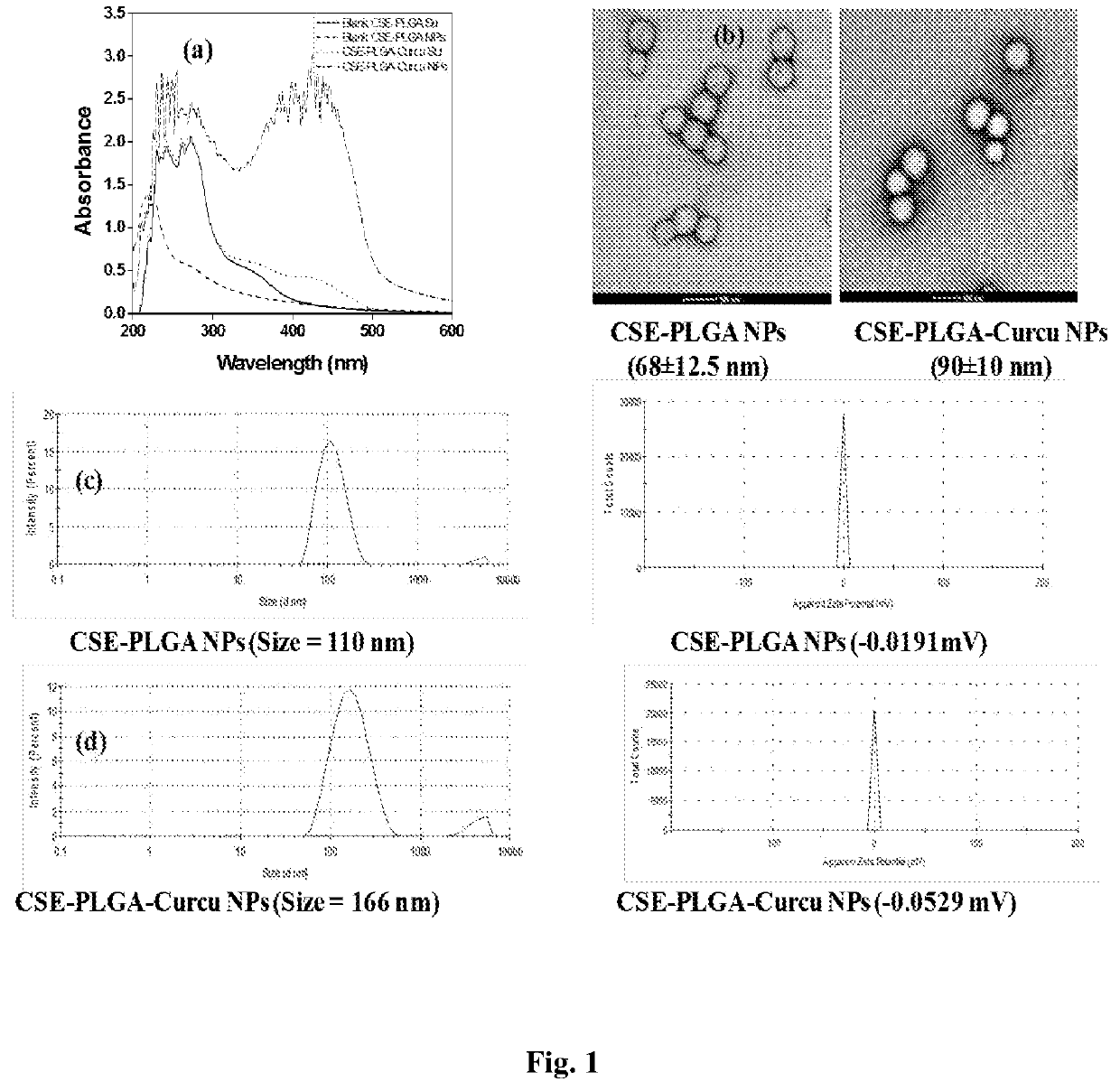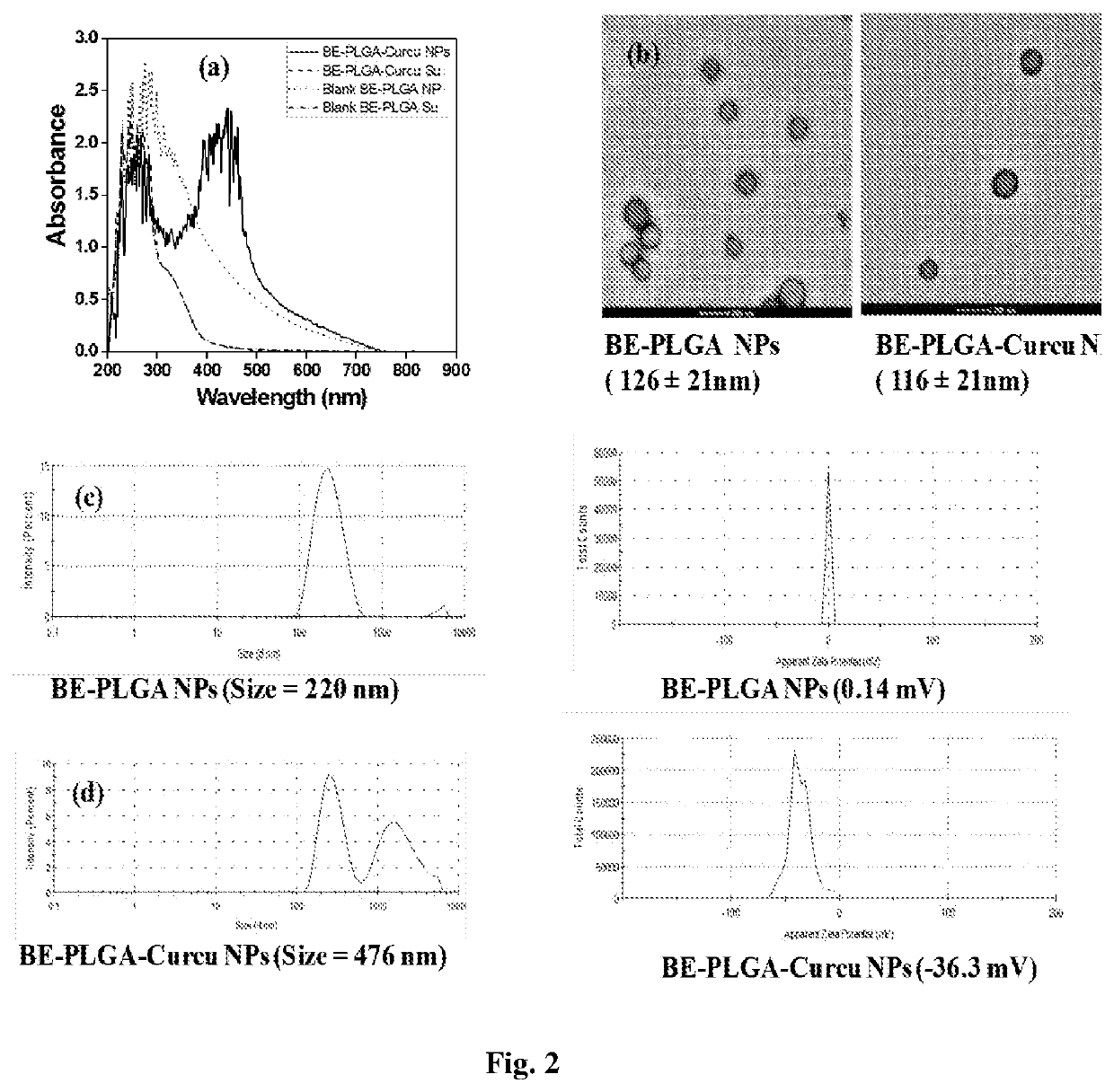A curcumin loaded stabilized polymeric nanoparticles with increased solubility and photo-stability and a green process for the synthesis thereof
- Summary
- Abstract
- Description
- Claims
- Application Information
AI Technical Summary
Benefits of technology
Problems solved by technology
Method used
Image
Examples
example 1
[0096]Preparation of Camellia sinensis Leaf Extracts
[0097]The Camellia sinensis leaves were collected from CSIR-IHBT, Palampur campus Bharmaat Palampur, Pin—176061, Kangra Himachal Pradesh, located at geographical coordinates 32° 06′18″ N and 76° 33′22″ E and at a height of about 1260 meters above mean sea level. Forty gram freshly crushed leaves of Camellia sinensis were dissolved in 500 ml double distilled water (DDW) and boiled for ˜30 minutes. The above solution was cooled to room temperature (25-30° C.) and filtered through Whatman filter paper and termed as Camellia sinensis leaf extract (CSE). The supernatant was used as such for the synthesis of PLGA NPs.
example 2
[0098]Preparation of Dendrocalamus hamiltonii Leaf Extracts
[0099]The Dendrocalamus hamiltonii leaves were collected from CSIR-IHBT, Palampur campus Bharmaat Palampur, Pin—176061, Kangra Himachal Pradesh, located at geographical coordinates 32° 06′18″ N and 76° 33′22″ E and at a height of about 1260 meters above mean sea level. Forty gram freshly crushed leaves of Dendrocalamus hamiltonii were dissolved in 500 ml double distilled water (DDW) and boiled for ˜30 minutes. The above solution was cooled to room temperature (25-30° C.) and filtered through Whatman filter paper and termed as Dendrocalamus hamiltonii leaf extract (BE). The supernatant was used as such for the synthesis of PLGA NPs.
example 3
[0100]Preparation of Rubus ellipticus Leaf Extracts
[0101]The Rubus ellipticus leaves were collected from CSIR-IHBT, Palampur campus Bharmaat Palampur, Pin—176061, Kangra Himachal Pradesh, located at geographical coordinates 32° 06′18″ N and 76° 33′22″ E and at a height of about 1260 meters above mean sea level. Forty gram freshly crushed leaves of Rubus ellipticus were dissolved in 500 ml double distilled water (DDW) and boiled for ˜30 minutes. The above solution was cooled to room temperature (25-30° C.) and filtered through Whatman filter paper and termed as Rubus ellipticus leaf extract (RE). The supernatant was used as such for the synthesis of PLGA NPs.
PUM
| Property | Measurement | Unit |
|---|---|---|
| Temperature | aaaaa | aaaaa |
| Temperature | aaaaa | aaaaa |
| Temperature | aaaaa | aaaaa |
Abstract
Description
Claims
Application Information
 Login to View More
Login to View More - R&D
- Intellectual Property
- Life Sciences
- Materials
- Tech Scout
- Unparalleled Data Quality
- Higher Quality Content
- 60% Fewer Hallucinations
Browse by: Latest US Patents, China's latest patents, Technical Efficacy Thesaurus, Application Domain, Technology Topic, Popular Technical Reports.
© 2025 PatSnap. All rights reserved.Legal|Privacy policy|Modern Slavery Act Transparency Statement|Sitemap|About US| Contact US: help@patsnap.com



